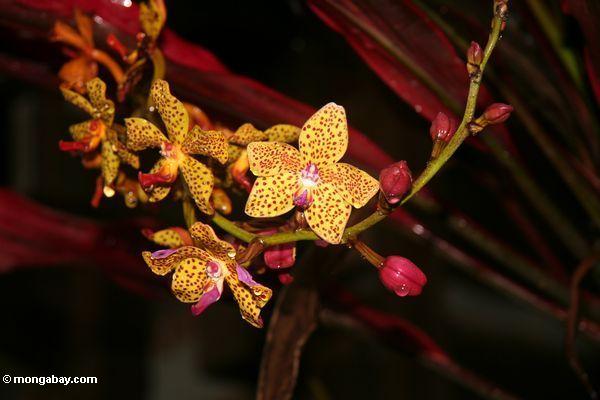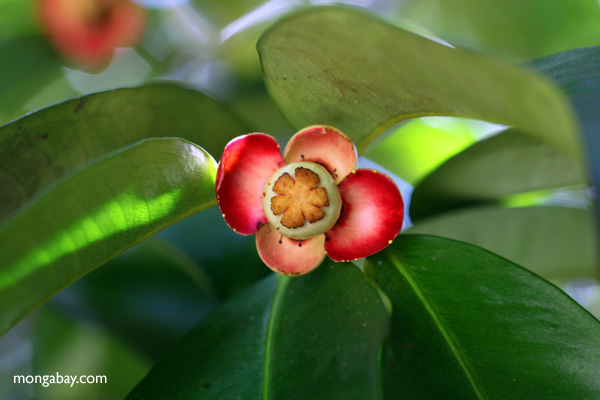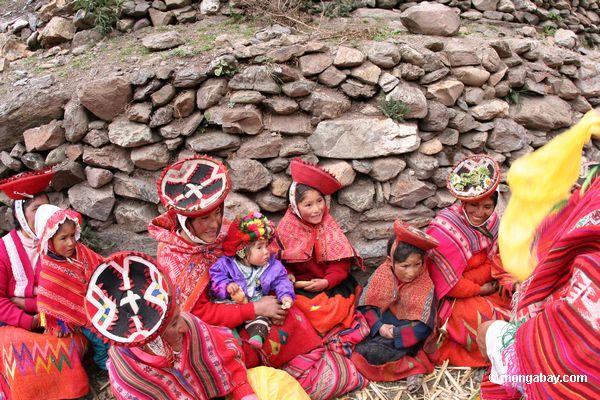How to save biodiversity
APPRECIATING THE BENEFITS OF PLANT BIODIVERSITY
By John Tuxill
From "State of the World, 1999." Copyright í 1999, Worldwatch Institute. Publication is available from Worldwatch Institute, 1776 Massachusetts Avenue, N.W., Washington, D.C. 20036. http://www.worldwatch.org

Colombia

Orchid in Indonesia
KEEPING DIVERSITY IN PLACE
In the end, plant diversity can be securely maintained only by protecting the native habitats and ecosystems where plants have evolved. Countries have safeguarded wildlands primarily through establishing national parks, forest reserves, and other formally protected areas. During this century, governments have steadily increased protected area networks, and they now encompass nearly 12 million square kilometers, or about 8 percent of the Earth's land surface. Many protected areas guard irreplaceable botanical resources, such as Malaysia's Mount Kinabalu National Park, which safeguards the unique vegetation of southeast Asia's highest peak. A few reserves have been established specifically to protect useful plants, such as the Sierra de Manantlan biosphere reserve in Mexico, which encompasses the only known populations of perennial wild corn.

Red fruit in Panama
Yet current protected area networks also have major limitations. Many highly diverse plant communities, such as tropical deciduous forests, are greatly under-protected. In addition, many protected areas officially decreed on paper are minimally implemented by chronically underfunded and understaffed natural resource agencies. But perhaps the most fundamental limitation of national parks, wilderness areas, and similarly strict designations arises when they conflict with the cultural and economic importance that plants hold for local communities.
A great deal of the natural wealth that conservationists have sought to protect is actually on lands and under waters long managed by local people. Indigenous societies worldwide have traditionally protected prominent landscape features like mountains or forests, designating them as sacred sites and ceremonial centers. In parts of West Africa, sacred groves hold some of the last remaining populations of important medicinal plants. On Samoa and other Pacific islands, communities manage forests to produce wild foods and medicines, raw materials for canoes and household goods, and other benefits.

Deforestation in Borneo
Not surprisingly, actions such as evicting long-term residents from newly designated forest reserves, or denying them access to previously harvested plant stands, have generated a great deal of ill will toward protected areas worldwide. Fortunately, workable alternatives are emerging in a number of cases where long-term residents have been made equal partners in managing protected lands. In the Indian state of West Bengal, 320,000 hectares of semideciduous sal forest is managed jointly by villagers and the state forestry department, with villagers taking primary responsibility for patrolling nearby forest stands. Since joint management began in 1972, the status of the sal forests has improved, and regenerating stands now provide villagers with medicines, firewood, and wild-gathered foodstuffs. Medicinals also feature prominently in a 4,000-hectare rainforest reserve in Belize, which is government-owned but managed by the Belize Association of Traditional Healers.
Such collaboration between locals and professional resource managers is also crucial to reversing the overexploitation of valuable wild plants. Very few commercially marketed wild species are harvested sustainably, in ways or at levels that do not degrade the plant resource. Despite the lack of progress, however, the foundations of sustainability are becoming increasingly clear. Secure and enforceable tenure is essential -- either in the form of rights to harvest a plant or tenure over the land it grows on. Harvesters also need enough economic security to be able to afford the tradeoffs involved in not harvesting everything at once. Access to fair and open markets is important, as is having technology appropriate for the harvesting task. Information about the ecology and productivity of a plant can make a big difference. Consumers willing to pay a premium for well-harvested products also help -- like those generated through certification programs for "environmentally friendly" products.

Rainforest in Indonesian Borneo
Few wild harvests meet all these criteria, but a growing number of initiatives are coming close. In Mexico, ancient cone-bearing plants called cycads have been heavily exploited for their ornamental value, both for sale domestically and for horticultural export to the United States, Japan, and Europe. Most cycads are wild-harvested by uprooting or cutting, but a botanical garden in the state of Veracruz is working with local villagers to reduce pressures on several overexploited species. In one community, Monte Oscuro, residents set aside a communal plot of dry forest to protect a relict population of cycads in exchange for help with building a community plant nursery. Seeds are collected from the wild plants, then germinated and tended in the nursery by villagers who have received training in basic cycad propagation. Some of the young cycads are returned to the forest to offset any potential downturn in the wild population from the seed harvest. The rest are sold and the profits deposited in a community fund.
Presently the largest hurdle is finding good markets for the young plants the communities are producing; cycads are slow-growing, and horticultural buyers prefer larger plants. Better monitoring and enforcement of the international ornamental plant trade would help, for Mexican cycad species are listed with the Convention on International Trade in Endangered Species of Wild Fauna and Flora (CITES) of 1973, which provides a powerful legal tool for controlling international trade in threatened plants and animals. CITES is generally regarded as one of the more effective international environmental treaties. It prohibits trade in the most highly endangered species (listed in the Treaty's Appendix I), and keeps watch on vulnerable species (listed in Appendix II) by requiring that countries issue a limited number of permits for the species' export and import between signatory countries. Although CITES provides powerful tools for enforcing sustainable harvests, it is still up to the countries involved to use them.

Indigenous Ticana kids in Colombia
Combining local and international strengths also is crucial for sustaining the genetic diversity of our food supply. What is needed most is agricultural development that strengthens rather than simplifies plant diversity to meet the needs and goals of farmers -- especially subsistence farmers in developing countries who still maintain diverse agricultural landscapes.
Meeting this challenge requires understanding the particular cultural, economic, and technological reasons why farmers maintain elements of traditional farming, such as unique crop variety mixtures. For instance, native Hopi communities in the southwest United States maintain indigenous corn and lima bean varieties because the germinating seeds are indispensable for religious ceremonies. Mende farmers in Sierra Leone continue to grow native red-hulled African rice for the same reason. Andean peasant farmers still grow pink and purple potatoes, big-seed corn, quinoa, and other traditional crops because that is what they themselves prefer to eat; the commercial varieties they grow are strictly to sell for cash income.

Logging in Borneo, Indonesia
One option to help farmers maintain crop diversity could involve supporting farmers' informal networks of seed exchange and procurement, so as to improve their access to diverse seed sources. In some rural communities in Zimbabwe, villagers contribute seeds annually to a community seed stock. At the start of the planting season, the seeds are redistributed to all community members, a step that gives villagers access to the full range of varietal diversity present in the immediate vicinity and ensures that no one goes without seeds for planting. Grassroots organizations in Ethiopia, Peru, Tonga, and many other countries have sponsored community seed banks, regional agricultural fairs, seed collection tours, demonstration gardens, and similar projects to promote informal seed exchange between farmers, increase their access to crop diversity, and help them replenish seed stocks after poor harvests.
Another approach to maintaining varietal diversity involves reorienting formal plant breeding toward the local needs of farmers. Typically plant breeders create uniform, widely adaptable "purebred" varietal lines, and only toward the end of the process are the lines evaluated with farmers. Participatory plant breeding methods involve farmers at all stages. In the most advanced programs, breeders and farming communities work together over several crop generations to evaluate, select, combine, and improve a wide range of varieties, both those available locally and those from other regions. In this way, participatory plant breeding can improve the suite of locally preferred varieties without resorting to varietal uniformity; this approach maintains -- or potentially even enhances -- the genetic diversity present in farmers' fields.

Rainforest in Malaysia
Participatory plant breeding has been pioneered primarily by grassroots development organizations and innovative national plant breeding programs in developing countries; it has not been taken up by commercial seed producers, perhaps because its benefits tend to be diffuse and not easily appropriated for commercial gain. The CGIAR centers are exploring participatory approaches, but also remain heavily involved in standard breeding programs. For instance, the corn and wheat center CIMMYT recently collaborated with university breeders and seed companies to develop better-yielding corn varieties targeted for highland Mexico -- areas where corn landraces continue to be grown by small-scale farmers under diverse environmental conditions. In doing so, CIMMYT chose to focus on hybrid corn varieties. If well tailored to the environmental and economic constraints facing highland Mexican farmers, the new hybrids could boost crop yields -- but farmers will be unable to save their seeds and adapt them further to local conditions. The seed companies involved will surely benefit, but past experience suggests that local plant biodiversity may pay the price.
As this last example shows, the most fundamental changes to be made in protecting crop genetic diversity -- and plant biodiversity in general -- involve changing policies. Governments are often biased toward promoting intensive agriculture dependent on high inputs and genetically uniform crops. Farmers in most southern African countries, for instance, are only eligible for government agricultural credit programs if they agree to plant modern improved varieties. International development aid and structural adjustment policies commonly promote nontraditional export crops, which can trigger habitat conversion (erasing wild plant diversity) and replace indigenous crop mixtures. Until fundamental policy changes are taken to heart by governments, international lenders, and related institutions, the path to sustaining plant biodiversity -- wild or domesticated -- will remain difficult.

Willoq community in Peru
SHARING THE BENEFITS
Governments can begin to chart a new course by resolving the most prominent policy issue affecting plant diversity today: how to distribute biodiversity's economic benefits fairly and equitably. Establishing a system of intellectual property rights to plant resources has proved contentious because of a simple pattern -- plant diversity (both wild and cultivated) is held mostly by developing countries, but the economic benefits it generates are disproportionately captured by industrial nations. For most of this century, plant diversity has been treated as the "common heritage" of humankind, freely available to anyone who can use it, with proprietary ownership only granted via patent law to individuals who demonstrate trade secrets or uniquely improve a crop variety or other plant.

Rainforest in Malaysia
Since the early 1980s, however, there has been widening agreement that indigenous people and traditional farmers deserve compensation for their long-standing generation, management, and knowledge of biodiversity. Grassroots advocates argue that indigenous people deserve "traditional resource rights" to the plants they cultivate and know how to use, rights that would have the same international legal standing as that afforded to patent rights. Recognition of such rights requires, at a minimum, negotiating equitable benefit-sharing agreements at the community level whenever plants or indigenous knowledge about them is collected by researchers. An additional way to acknowledge the world's debt to rural communities who safeguard plant biodiversity would be to establish an international fund supporting continued local management of plant resources. Such a step appears the most practical means of compensation for the large amount of plant biodiversity that is already in the public domain (such as the millions of seed accessions in gene banks or plants widely used as herbal medicines), since establishing exactly who deserves compensation for commercial innovations from these plant resources is a Herculean task.
To date, formal agreements for sharing the benefits of plant diversity have been negotiated most extensively in the search for new pharmaceuticals from plants in biodiversity-rich developing countries. The first such "bioprospecting" agreement was announced in 1991 between Merck Pharmaceuticals and Costa Rica's nongovernmental National Institute of Biodiversity (InBio), in which Merck paid InBio $1.1 million for access to plant and insect samples, and promised to share an undisclosed percentage of royalties from any commercial products that resulted.

Borneo rainforest
There are now at least a dozen bioprospecting agreements in place worldwide, involving national governments, indigenous communities, conservation groups, startup companies, and established corporate giants. Most legitimate agreements have followed the Merck-InBio model, with a modest upfront payment and a promise to return between one quarter of 1 percent and 3 percent (depending on the project) of any future royalties to the biodiversity holders. Bioprospecting proponents argue that with the huge cost ($200-350 million) of bringing a new drug to market, companies cannot afford to share a higher percentage of royalties. Critics, however, suspect many bilateral bioprospecting agreements are not negotiated on an even footing; when a biotechnology firm approached the U.S. government about prospecting for unique microbes inhabiting the geysers and hot springs of Yellowstone National Park, for instance, the Park Service negotiated a royalty share of 10 percent. Moreover, not all bioprospecting agreements automatically uphold traditional resource rights; many have been negotiated on a national rather than community level, involving governments who many indigenous people think do not adequately represent -- indeed, sometimes actively undermine -- their interests.
In contrast with bioprospecting, resolving who owns the world's crop genetic resources is being negotiated multilaterally, in factious diplomatic arenas. In 1989, FAO adopted a Farmers' Rights proposal that would compensate farmers for their contribution to biodiversity via an international trust fund to support the conservation of plant genetic resources. The 1992 Convention on Biological Diversity also called for incorporating Farmers' Rights, subsequent to further international negotiations. There has been no official endorsement of this concept, however, from the industrial nations who would provide the compensation, and the fund has remained unimplementedí

Deforestation in Malaysia
For all of human history, we have depended on plants and the rest of biodiversity for our soul and subsistence. Now the roles are reversed, and biodiversity's fate depends squarely on how we shape our own future. From reducing overexploitation of wild plants to establishing traditional resource rights for biodiversity stewards, many options are available for developing cultural links that support plant diversity rather than diminish it. Such steps are not just about meeting international treaty obligations or establishing new protected areas, but rather are part of a larger process of shaping literate civil societies that are in balance with the natural world. To maintain biodiversity's benefits, what matters most is how well we meet the challenges of living sustainably with our deeds as well as our words.
Previous











